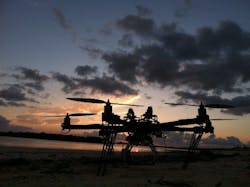Americans aren’t comfortable with drones in their hometowns. That was the short summary of a public opinion research poll about UAV drones conducted by Monmouth University Polling Institute. The poll research said that while most people are OK with UAV drones for search and rescue, they’re less excited, but generally OK with drones for border surveillance and tracking down criminals (2/3rds said they would support such use cases). Where they draw the line was the use of drones on themselves. Only a quarter of the respondents supported use of UAV drones for issuing speeding tickets, and about 4 out of 5 said they would have concerns with law enforcement loading on high-tech cameras and using the drones for surveillance.
The American public may have reservations, but I would say that “public opinion be damned”, this technology is coming.
We’ve already seen public officials support for drone UAVs (unmanned aerial vehicles), with Virginia Governor Bob McDonnell saying he would support police use of drones in his state for reasons of increased law enforcement productivity. It’s not a far jump to the world of speeding tickets, I suppose, especially since it’s fairly common to see the “Speed limit enforced by aircraft” signs on the state’s roads. (For a detailed discussion of how aerial speed limit enforcement works, I recommend this discussion thread on aircraft-issuance of speeding tickets from our sister website Officer.com.)
The reason the technology is coming is 3-fold. First, military-grade technology often moves downstream to law enforcement and corporate security as it loses its classification level and as it becomes more affordable. Second, as we’ve seen in our Secured Cities conference, cities have been very keen on investing in force-multiplier technology. If you’re limited on officers, think like a chief. Once the technology matures, a drone and an officer would both be able to capture speeders, but only an officer can interview witnesses and develop informants. You put your resources where they are best applied based on your available funding. Third, there’s an upstream movement of this technology from hobbyists that is at work as well.
This upstream movement from hobbyists and from the cinematography/broadcast industry recently came to my attention when I heard of the company Quadrocopter that sells UAV systems for cinematography. Here’s why it’s heading upstream: Quadrocopter is selling complete UAV systems from $3,000 to $6,500 for the CineStar solution (see a cool video of a CineStar UAV filming in snowy weather). The $6,500 version not only allows for the flying UAV ability, but it also includes full gimbals control for the pan/tilt controls of the camera payload. These units can handle payloads of up to three pounds and can fly up to about 10 minutes. That kind of payload supports high-quality cameras with great lenses and that amount of flying time allows for actual surveillance operations. Think about this: How long would it take to fly a unit like that up to a window on a building to see if the suspects are in there making a drug deal?
That upstream movement, combined with the support from public officials and the downstream movement of technology that came out of the military is going to mean that drones are coming. They’re already heading to the southern border, which makes sense. According to the International Boundary & Water Commission, the U.S.-Mexico border is 1,954 miles long, which makes it a manpower monster. Last decade’s virtual fence concept SBInet was a failed project, so it makes sense that drones are going to become a popular technology for border security – especially when you consider the drug cartel violence that is occurring around the border. They’re already headed to the London Olympics, as well, so where is this coming next?
It’s a big leap from using drones for high security events, border patrol and military applications to using them in our hometowns and cities. There are FAA airspace issues and the aforementioned privacy concerns. There are costs that have to come down. Just recently, we’ve seen bills introduced that would expressly require warrants for domestic surveillance use of drones. But like it or not, that leap will happen, and I believe there will be a day when the technology become ubiquitous.



